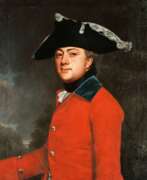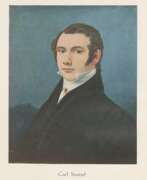Kingdom of Prussia 18th century


Carl Daniel David Friedrich Bach was a German artist of the late eighteenth and early nineteenth centuries, the Baroque period. He is known as a painter, graphic artist and printmaker.
Bach worked in the historical genre, was a portraitist, animalist, created canvases on allegorical subjects in the spirit of his era. In his works he combined elements of baroque and classicism. The artist often worked in the etching needle technique.


Baron Eben, full name Christian Adolph Frederick d'Eben, was a Prussian officer and artist.
Baron Eben, descended from an old Prussian family in Silesia, entered the English service in 1800 and served in the 10th Regiment of the Prince of Wales's Light Dragoons. By order of the Prince of Wales, he created a company of light cavalry in the manner of the Hungarian Hussars, composed of foreigners. He also made original drawings, which, in the form of bright aquatints by the engraver Nicholas Heideloff, were included in a 29-page manual entitled "Remarks on the Organization and Present State of the Swedish Army". Eben dedicated this work to the Prince of Wales.


Ekaterina II, Ekaterina the Great; née Sophie Auguste Frederike von Anhalt-Zerbst-Dornburg, in Orthodoxy Ekaterina Alekseevna, was the Russian Empress and Sovereign of All Russia, mother of Emperor Paul I.
She was a niece of Swedish King Adolf Friedrich and a great-niece of Prussian King Frederick the Great. Sophie was a niece of the Swedish King Adolf Friedrich, and a great-niece of the Prussian King Frederick the Great. In 1744, at the invitation of Russian Empress Elizabeth Petrovna, she and her mother came to Russia, embraced Orthodoxy and was baptized with the name Ekaterina Alekseevna, and in 1745 married Grand Duke Peter Fyodorovich, the future Emperor Peter III. Immediately after arriving in Russia, Ekaterina II began to study the Russian language, history, and Russian traditions. She also read the works of the French enlighteners and works on philosophy, jurisprudence and economics, becoming a supporter of the ideas of the Enlightenment.
After the accession to the throne of Peter III, Ekaterina's relations with her husband deteriorated. Because of the threat of arrest and possible expulsion, Ekaterina decided to participate in the coup d'état, relying on the support of the Orlov brothers, Counts N. Panin and K. Razumovsky. On the night of June 28, 1762 Catherine secretly arrived in St. Petersburg and in the barracks of the Izmailovsky Regiment was proclaimed autocratic empress.
In the first years of her reign, Ekaterina II reformed the Senate, secularized church lands, which replenished the state treasury and alleviated the situation of a million peasants, abolished hetmanism in Ukraine, invited foreigners to Russia for the development of the Volga and Black Sea region. The Empress carried out important transformations in the military, social and financial spheres.
During her reign, Ekaterina II conducted two successful Russian-Turkish wars in 1768-1774 and 1787-1791, as a result of which Russia finally gained a foothold on the Black Sea. Having led an alliance with Austria and Prussia, Ekaterina participated in three partitions of Poland. In 1795, the empress issued a manifesto on the annexation of Courland to the Russian Empire. At the end of the 1780s, simultaneously with the Russo-Turkish war, the war with Sweden began, and in 1790 a peace treaty was signed, ending the Russo-Swedish war. In 1792 the Peace of Iasi was concluded, which consolidated Russia's influence in Bessarabia and Transcaucasia, as well as the annexation of Crimea.
Under the rule of Empress Ekaterina the Great, a whole pleiad of outstanding statesmen, military leaders, writers and artists appeared. Among them are Adjutant General I.I. Shuvalov, Generalissimo A.V. Suvorov, Field Marshal General G.A. Potemkin; enlightener, book publisher N.I. Novikov; historian, archaeologist, artist, writer, collector A.N. Olenin, President of the Russian Academy E.R. Dashkova.
Ekaterina II was buried in the vault of the Peter and Paul Cathedral. After 77 years in St. Petersburg on Alexandrinskaya Square was inaugurated a monument to the great empress. In the history of Russia she rightfully entered first of all as an enlightener.


Janus Genelli was a German painter of the late 18th and early 19th centuries of Italian origin. He is known as a landscape painter and is considered a representative of classicism.
Genelli was famous for his idealistic depiction of nature, especially the Harz region and its mountains. From 1803, he became an art teacher to Queen Louise of Prussia and her son, Crown Prince Friedrich Wilhelm. Although Genelli's work is little known today, he was considered a genius in his day and his work was highly regarded by his contemporaries. His son Bonaventura Genelli also became a renowned painter and graphic artist.


Georg Lisiewski was a German painter of the first half of the 18th century of Polish origin who lived in Royal Prussia. He is known as a painter and portraitist.
Lisiewski became famous for his single and group portraits, which were popular among the Prussian aristocracy and royal family. King Frederick William I appointed him as his court painter.
Lisiewski founded an influential dynasty of artists in Germany that lasted for more than three generations. His daughters Anna Rosina and Anna Dorothea, as well as his son Christoph Lisiewski, became famous artists.


Christian Bernhard Rode was a German painter of the second half of the eighteenth century. He is known as a historical painter and printmaker, closely associated with the Berlin Enlightenment movement.
Bernhard Rode became famous for his works depicting historical events and allegorical works. His works combined a variety of techniques, including paintings, engravings, book illustrations, and reliefs. He embodied motifs from the Old Testament, ancient mythology, history, and literature contemporary to him.
Rode was director of the Berlin Academy of Fine Arts from 1783 to 1797.


Johann Peter von Langer was a German painter of the last quarter of the eighteenth and first quarter of the nineteenth centuries. He is known as an academic painter, draughtsman and printmaker, as well as a teacher.
Von Langer painted religious and historical paintings and portraits, as well as graphic illustrations. Many of his drawings and engravings are preserved in the State Graphic Collection in Munich. Langer was the director of the Academy of Fine Arts in Munich. In 1808 he received the title of Bavarian nobility. The master's contribution to art was also recognized in the Netherlands, where he was accepted as a member of the Royal Academy.


Samuel Thomas von Soemmering was a German physician, anatomist, anthropologist, paleontologist, physiologist and inventor.
He studied medicine at Göttingen, where he received his doctorate, and in the same year became professor of anatomy at Kassel, then at Mainz. Among Soemmering's contributions to biology are the discovery of the macula in the retina of the human eye, studies of the brain, lungs, nervous system, and embryonic malformations, and he published many papers in the fields of neuroanatomy, anthropology, and paleontology. He was the first to give a reasonably accurate account of the structure of the female skeleton.
Soemmering also worked on fossil crocodiles and pterodactyls, which at the time were called ornithocephalians. In addition, Soemmering dabbled in chemistry, astronomy, philosophy, and various other fields of science. Among other things, he investigated the refinement of wines and sunspots, and designed a telescope for astronomical observations. In 1809, Soemmering developed a sophisticated telegraph system based on electrochemical current, which is now preserved in the German Science Museum in Munich.


Friedrich Georg Weitsch was a German painter of the late 18th and early 19th centuries. He is known as a painter and printmaker.
Weitsch created landscapes, historical and religious subjects, but a special place in his work was occupied by portraits of aristocrats, as well as ordinary people. His works are in various museums, including the Braunschweig City Museum, the Braunschweig Land Museum, and the Duke Anton Ulrich Museum of Braunschweig-Wolfenbüttel.



